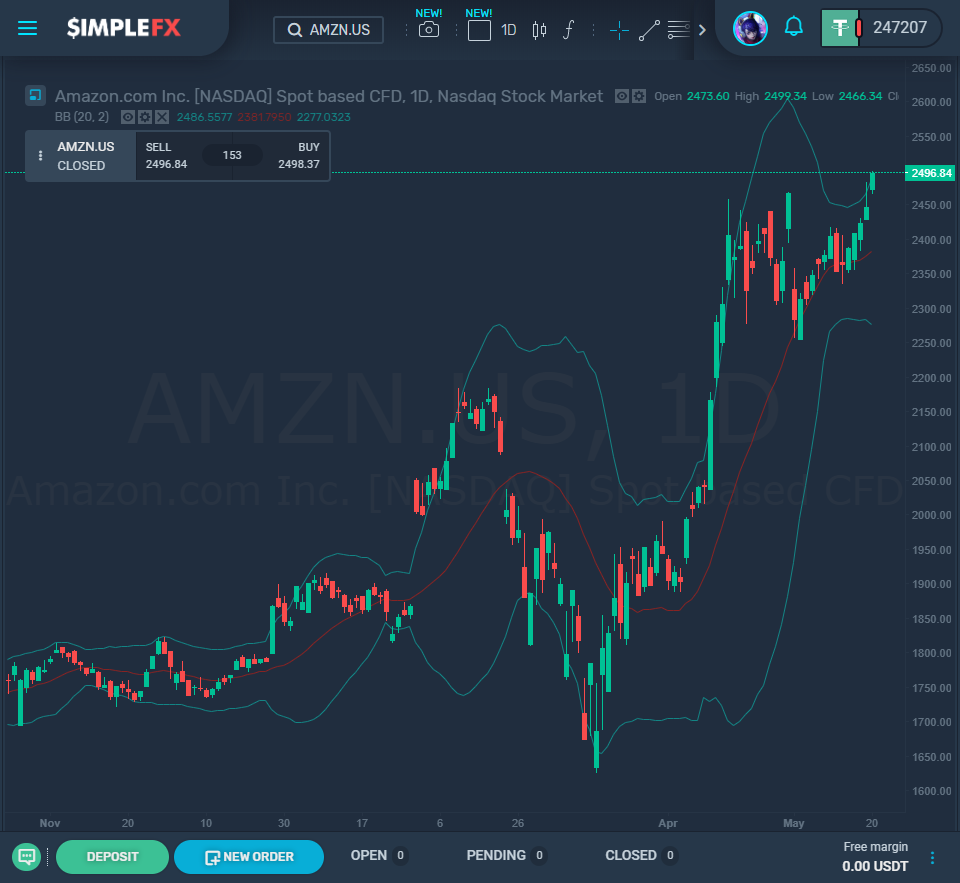Stay-at-home directives have certainly been good news for Amazon (AMZN). Product demands have surged, and the response during the lockdown has been a colossal task with the expansion of operations and answers to customers’ needs. For some people, it has been their first dabble with online retail.
However, the world pandemic has also meant other trends that were in motion have accelerated. It’s highly likely that these trends are set to be commonplace much faster than initially anticipated in the post-coronavirus world. One such direction is cloud services.
[button link=”https://app.simplefx.com/login” size=”medium” target=”new” text_color=”#eeeeee” color=”#df4444″]SELL Amazon[/button] [button link=”https://app.simplefx.com/login” size=”medium” target=”new” text_color=”#eeeeee” color=”#3cc195″]BUY Amazon[/button]
With more and more people successfully working from home, this way of working will likely gain steam even when the easing of restrictions occurs. Of course, this means that cloud infrastructures need to be robust. And who could benefit from this need? Of course, Amazon.
Werner Vogal, Amazon CTO, issued a keynote address during an AWS online summit which followed Brian White, 5-star Monness analyst commenting: “With a positive, secular cloud trend and now the COVID-19 crisis, Werner believes that ‘most organizations will be transforming into a completely cloud-based environment’ in 2020 and beyond… Moreover, video streaming has taken on a life of its own during this crisis, with AWS supporting the leading streaming and video conferencing platforms.”
If we look just at video streaming, it is clear that it is a hallmark of this crisis. Conviva data shows that streaming during daylight hours rose by 39% during the week 17-23 March. Further, Nielsen released data showing that the U.S. had 161.4 billion minutes of streaming video for the week of March 30, which is almost 100 billion more compared to the very same week during 2019. Yet, is it possible for this trend to continue once this Covid-19 crisis is out of the way (whenever that may be)?
It is likely, yes. White says that AWS has “the widest array of databases in the cloud” as well as simplifying solutions for integrating machine learning to SaaS services, there aren’t many that would not be betting against Amazon and nor would White.
As a 5-star analyst, White has AMZN shares on a Buy rating accompanying a price target of $2,800. What are the implications for those investing then? There’s a 14% upside potential. Here is the track record for White.
Others like what they see, too. The Strong Buy consensus rating for Amazon is based on 1 Sell, 2 Holds, and 38 Buys. Analysts also expect further possible gains of 9% in the coming year and have a current average price target of $2,673.17.
After Amazon.com (NASDAQ: AMZN) announced the first-quarter earnings on April 30, the shares fell by around 5% in trading after-hours. The next few days saw investors take the stock down almost 9%, but why had this spooked them?
[button link=”https://app.simplefx.com/login” size=”medium” target=”new” text_color=”#eeeeee” color=”#df4444″]SELL Amazon[/button] [button link=”https://app.simplefx.com/login” size=”medium” target=”new” text_color=”#eeeeee” color=”#3cc195″]BUY Amazon[/button]
The earnings report had missed the analysts’ expectations, and rising costs meant that the company’s earnings per share were down by 29% year to year to $5.01, which was well below what analysts expected ($6.23). Also, possible congressional testimony, labor woes, and talk of investigations are quite likely to have driven many investors away.
It’s not all been plain sailing for the eCommerce giant, however. There has been negative press, walkouts, and attention coming from legislators and attorneys general with demands that Amazon does more in protecting workers. Amazon responded to these issues with a $4 billion investment for COVID-related expenses, including PPE (personal protective equipment) for employees.